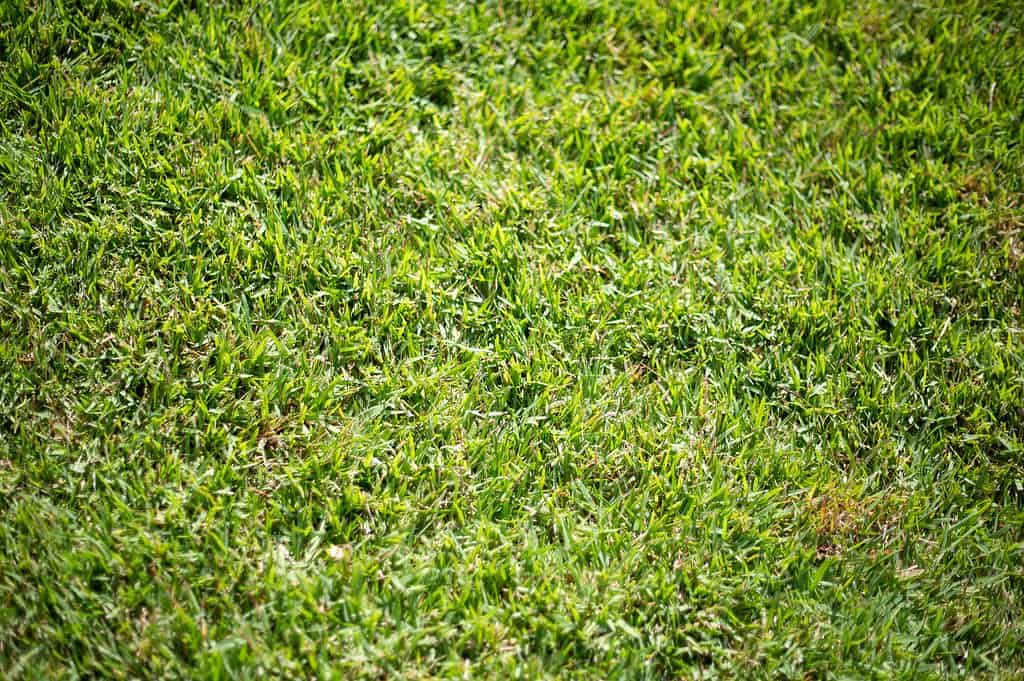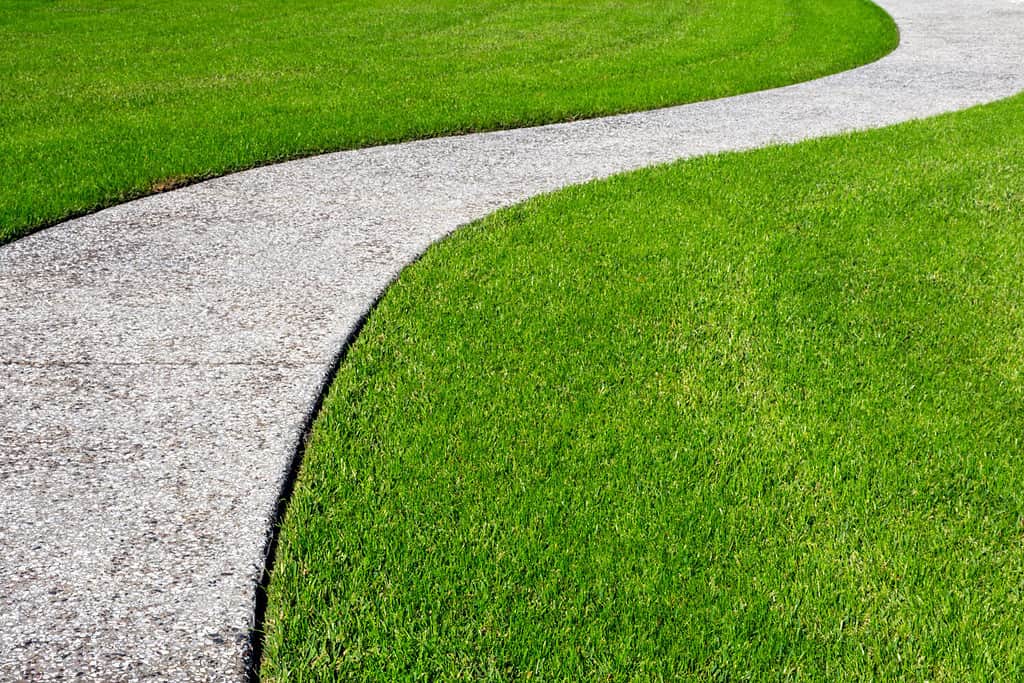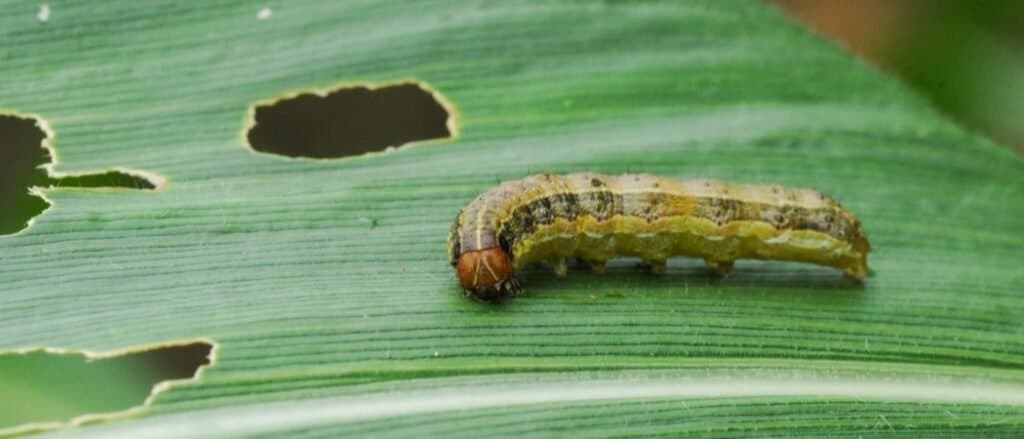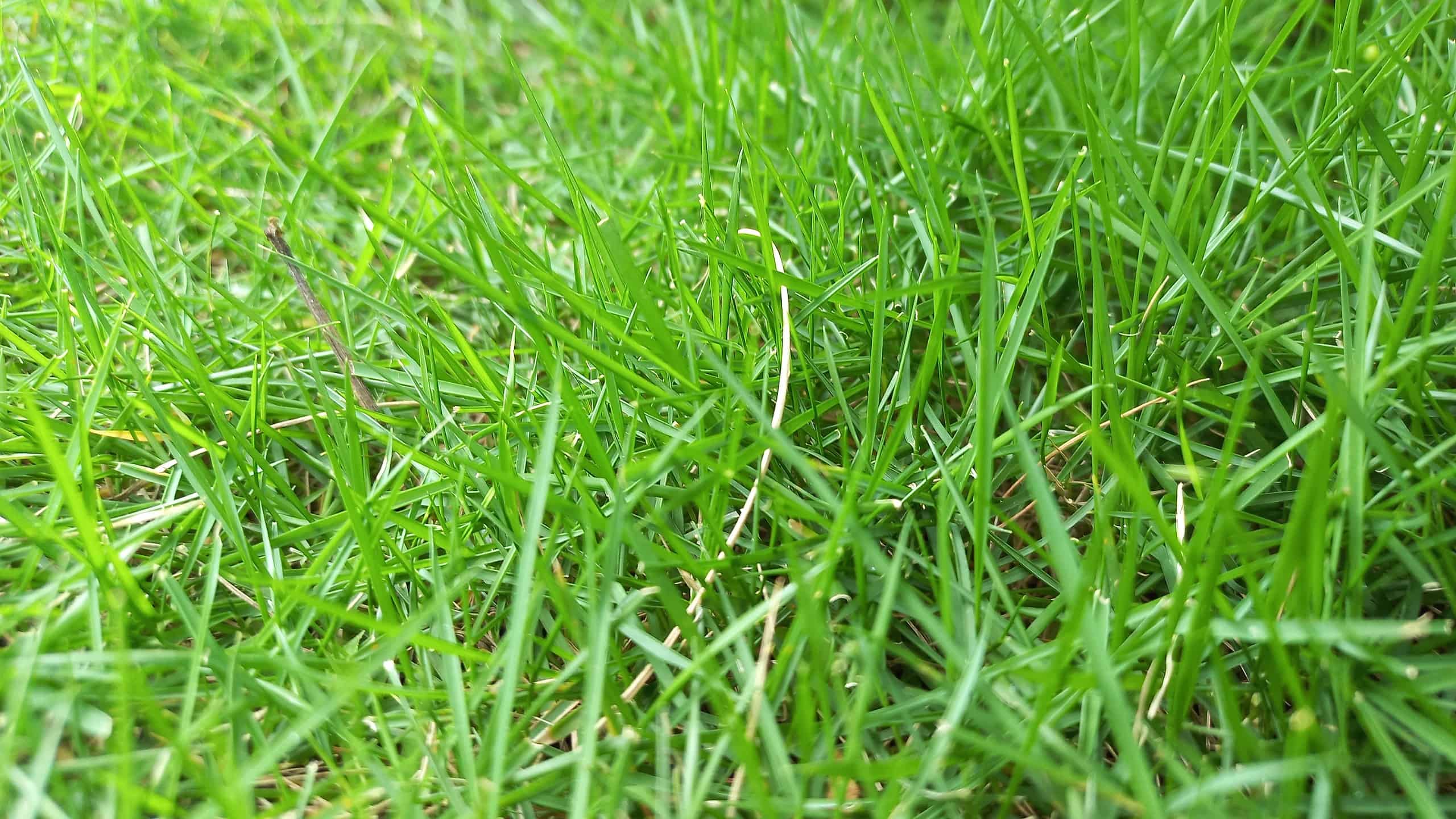Empire Zoysia grass should be taken into consideration if you want to transform your lawn into a lush, green carpet. Due to its remarkable features, this warm-season grass is a preferred option among landscapers and homeowners alike. Because of its exceptional adaptability, toughness, and minimal care requirements, Empire Zoysia is perfect for lawns, commercial buildings, golf courses, and other uses. Empire Zoysia grass is particularly popular in areas around the southern United States, where it can thrive with minimal human intervention and ongoing maintenence..
In this guide, we’ll explore all the pros and cons of using Empire Zoysia grass for a wide range of different sod use cases. We’ll break down what makes this type of grass so beneficial, as well as the downsides that might make you think twice about planting this type of grass in your own yard. That being said, Empire Zoysia grass is actually a very versatile and beautiful lawn grass that is used around the world.
What is Empire Zoysia?
Empire Zoysia grass is a medium-bladed, dark green Zoysia grass. It is a lovely, soft, and low-maintenance variety beloved by lawn owners for both residential and commercial use. It has good wear tolerance, needs less chemical treatment and mowing, and is resistant to ticks. Fortunately, this type of turf makes it possible to turn off the water supply during extreme droughts without running the risk of irreparable damage to the lawn.
This type of grass stands apart from other grasses thanks to its unusual appearance. Its fine-textured blades are gentler to the touch than Bermuda grass or similar grass. Lawns made of Empire Zoysia have a medium to dark green tint. Empire Zoysia has broader blades than other Zoysia grasses, giving it a more even and consistent look.
Empire Zoysia grass is renowned for its capacity to create a deep, luxuriant turf that is comfortable to walk on. It grows at a moderate rate, thus less mowing is necessary than with other grasses. Empire Zoysia grass adapts well to a variety of conditions because of its excellent tolerance for cold, shade, and drought.
The Origins of Empire Zoysia Grass
This type of grass was originally created in Brazil in the 1950s. It was bred by combining a tough Japanese grass called Zoysia japonica with a finer-textured Philippine grass called Zoysia tenuifolia. The end result was a Zoysia grass with traits from both species that were best when combined, including strong shade tolerance, dense growth, and disease resistance.
Empire Zoysia grass was brought to the United States in the 1990s. Because of its resilience to various soil types, climates, and rainfall patterns, it rapidly became popular in the southern regions. This type of grass is now one of the best warm-season grasses for lawns and landscapes and is readily accessible at sod farms and nurseries across the United States.
Empire Zoysia is loved by homeowners and landscapers because of its numerous benefits and advantages. However, it has its own set of benefits and drawbacks, just like any other variety of grass.

Empire Zoysia grass (pictured) is known for its low maintenance needs and rich, green color.
©Giulio Giampellegrini/Shutterstock.com
Pros of Empire Zoysia
Due to its many advantages, including its capacity to flourish in warm and humid regions, its minimal maintenance requirements, and its general beauty, this type of grass is a well-loved selection among homeowners and landscapers.
Low Upkeep Requirements
The fact that Empire Zoysia grass requires little upkeep is one of its biggest advantages. This is due to the grass’ ability to withstand droughts and thrive with minimal water. It also has deep roots, which let it draw moisture and nutrients from deeper soil strata. You’ll save time and money by not having to water your grass as regularly as before.
Just as well, you won’t need to apply as many pesticides or fungicides. This is because Empire Zoysia grass is also resistant to the majority of pests and illnesses. As a result, it is a safer and healthier choice for households with kids and pets.
Visual Appeal
With its vivid green hue and fine, thick texture, Empire Zoysia grass resembles a luxuriant carpet. Additionally, it has a regular growth pattern, which results in a beautiful lawn. For homeowners who desire a lovely lawn without the stress of regular upkeep, this makes it an excellent choice.
Can Tolerate Shade
Empire Zoysia grass is a wonderful choice for parts of your lawn that receive less sunshine because of its reputation for tolerating shadow. This type of grass is a great choice for locations beneath trees or close to buildings since it can take up to 40% shade, even if it still needs some sunshine to flourish.
Drought Tolerance
Empire Zoysia grass is drought-tolerant, meaning it can endure prolonged dry spells without perishing or falling dormant. For homeowners who reside in regions with protracted dry seasons or who wish to preserve water, this function is a major benefit.
Environmental Advantages
There are various environmental advantages to Empire Zoysia grass. It requires less water, fertilizer, and pesticides when compared to other species of grass. This has a lessening effect on the environment by minimizing the quantity of water and pollutants that wind up in the land and rivers.
Additionally, by keeping the soil in place, the dense roots of Empire Zoysia grass aid in preventing soil erosion. For regions with steep slopes or soil that is prone to erosion, this is especially advantageous.
Durability
Empire Zoysia grass is a very hardy variety of grass that can tolerate heavy traffic. This makes it a fantastic choice for households with families and outdoor pets. It will continue to be healthy and beautiful for many years because it is also resistant to the majority of pests and illnesses as well.
Cons of Empire Zoysia Grass
Slow Rate of Growth
The sluggish growth rate of Empire Zoysia grass is one of its drawbacks. It might be discouraging for homeowners who desire immediate results because it can take up to two years to produce thick and healthy grass lawns. But once it’s established, it needs less upkeep than other kinds of grass.
It Can Be Pricey
Empire Zoysia grass may be out of budget for some homeowners since it is more expensive than other grass varieties. Empire Zoysia grass prices vary depending on the size of the lawn and how it is installed, among other things. In the long term, however, Empire Zoysia’s endurance and minimal care needs could make up for its original expense.
It Can’t Handle Cold Weather
Since Empire Zoysia grass prefers warm climates without severe winters or frost, it should not be grown in hardiness zones that are very cold. During the winter, it will fall dormant, losing its vivid green hue and turning brown. It will, however, turn rich green again as springtime temperatures rise. In general, Empire Zoysia does best in USDA hardiness zones six through 11.

All types of Zoysia grass (pictured) are only really beneficial for lawns in temperate, high-temperature places.
©Joanne Dale/Shutterstock.com
High Sunlight Requirements
Despite being able to endure some shade, Empire Zoysia grass still needs some sunshine to flourish. It might not be the greatest choice in places with a ton of trees or other sunlight-blocking obstacles.
Should I Use Empire Zoysia Grass?
For homeowners and landscapers who want a lovely, low-maintenance lawn that can survive many weather conditions, this type of grass is a fantastic option. Many homeowners find it to be the best option due to its various advantages, including drought tolerance, shade tolerance, durability, and aesthetic appeal.
However, other homeowners may find it less ideal because of its sluggish growth rate, high cost, sensitivity to cold weather, and need for sunshine. Empire Zoysia grass should ultimately be chosen based on the homeowner’s particular requirements and preferences as well as the local climate and circumstances. Do your research!
Empire Zoysia Spread Rate
The spread rate of a grass variety, or how rapidly it can cover an area, is one of the most important aspects of lawn care to take into account. The Empire Zoysia’s spread rate should be taken into account since it influences how well it performs and how it needs to be maintained.
Compared to other grass varieties, this type of grass spreads at a moderate to sluggish rate. Stolons, which are above-ground runners that stretch outward from the parent plant and develop new roots and blades, are the primary means of this plant’s development. Under optimum conditions, such as enough sunlight, water, and nutrients, Empire Zoysia stolons grow at a rate of around four to six inches each year.
Empire Zoysia grass spreads slowly (around 1-2 inches per month on all sides during ideal growing conditions), which offers both benefits and drawbacks. In contrast to other grasses, this implies that Empire Zoysia grass grows into a dense, homogeneous lawn that needs less upkeep. The majority of weeds can be choked out by Empire Zoysia’s compact growth habit, which lowers the requirement for herbicides. This type of grass also generates less thatch, which is a covering of dead stems and roots that can build up on the soil’s surface and obstruct the soil’s ability to absorb water and nutrients.
The moderate to slow spread rate of Empire Zoysia grass has the drawback of making it more difficult to grow a new lawn or fill in dry places. Additionally, a slow spread rate indicates that this grass may be less resilient to harm or stress, and less tolerant of high foot activity. Empire Zoysia grass can also be more expensive to install than other grass species, such as Saint Augustine grass, since it spreads so slowly.
Factors That Affect Spread Rate
As mentioned above, Empire Zoysia grass can spread at a moderate to slow rate. However, it can spread at different rates depending on a number of variables, such as the following:
- Empire Zoysia grass likes fertile, well-drained soils with plenty of organic matter and nutrients. This grass can grow more slowly and generate fewer stolons if the soil is compacted, poorly drained, or deficient in nutrients.
- Even though this type of grass thrives in shade, it still requires some sunshine to develop and spread. This grass can grow more slowly and generate thinner stolons if the lawn is excessively shaded.
- Water and irrigation are other factors to consider. For Empire Zoysia grass to flourish and spread, it requires enough water. This grass can fall into hibernation and generate fewer stolons if the lawn is not properly irrigated. Likewise, it can develop more thatch and become more prone to disease if the lawn is overwatered.
- Empire Zoysia grass has to be mowed often to promote lateral growth and the development of stolons. This grass can grow more vertically and generate fewer stolons if it is cut too short or not often enough.
How to Care for Empire Zoysia
Compared to other grasses, this species of grass requires very minimal maintenance. However, it still needs some basic upkeep to survive. There are a few ways that regular maintenance can help your grass become healthier overall.
Watering Empire Zoysia
This type of grass requires about one inch of water per week, from irrigation or rainfall. To stimulate deeper roots, be sure to water plants sparingly and deeply rather than often and shallowly.
Sunlight for Empire Zoysia
In areas with hot and humid summers, Empire Zoysia can benefit from some afternoon shade to prevent heat stress and maintain its green color. However, it should not be grown in areas with constant shade or low light conditions, as this can lead to thinning and disease. If you are planning to grow this type of grass on your lawn, choose an area that receives full sun or partial shade during the hottest part of the day. Avoid planting it under large trees or in areas with buildings or other structures that can cast long shadows throughout the day.
Fertilizing Empire Zoysia
Regular fertilizing helps keep this type of grass healthy and its iconic deep green. Throughout the growing season, use a slow-release fertilizer approximately every six to eight weeks. High-nitrogen fertilizers should be avoided since they might promote excessive growth and thatch buildup.
Thatch Control for Empire Zoysia
Thatch accumulation on Empire Zoysia grass can block water and nutrients from reaching the root system over time. Any excessive thatch buildup should be removed with a dethatching rake or machine. Dethatching should be avoided during the growing season since it might harm the grass blades and cause brown areas.
Mowing Empire Zoysia
Empire Zoysia grass should be cut at a height of around one to two inches. However, this depends on the season and the amount of foot activity. Cutting more than one-third of the grass blade at once should be avoided. Doing so might stress the plant and increase its susceptibility to disease.
Weed and Pest Control for Empire Zoysia
Chinch bugs, armyworms, and other common lawn pests can still harm this type of grass even if it is resistant to the majority of pests and illnesses out there. To avoid infestations, use a pesticide or a natural pest control technique such as neem oil. To stop weeds from growing, apply a pre-emergent herbicide according to the product’s instructions.

Armyworms (pictured) can quickly damage all types of Zoysia grasses, as well as other plants in and around your lawn.
©kale kkm/Shutterstock.com
For homeowners looking for a gorgeous, low-maintenance lawn, Empire Zoysia grass is a great option. Empire Zoysia stands out for its thick growth, supple texture, and resilience to pests and diseases. Plus, you can’t deny that this type of Zoysia grass looks absolutely stunning in a wide range of applications. If you live in the southern United States, this is a top-notch Zoysia grass to try!
Thank you for reading! Have some feedback for us? Contact the AZ Animals editorial team.








